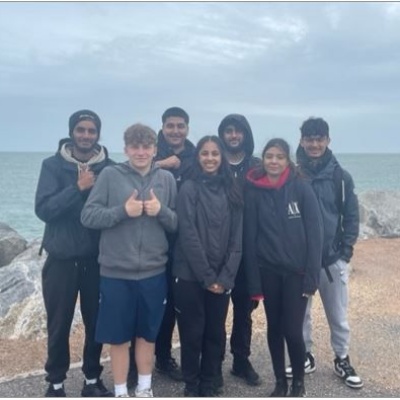A Level Geography Field Trip

In late September, the Geography department took the A-Level Geographers on a field trip to Slapton Sands in beautiful Devon to collect primary data for our NEA's. Here's what we got up to!
Day 1: Setting the Stage
Our journey began with a scenic bus ride that whisked us away from the hustle and bustle of life in Heston to the serene coastal setting of Slapton Sands, Devon. As soon as we arrived, I was struck by the sheer expanse of the beach and the rugged beauty of the surrounding area. We arrived at our field studies centre and quickly headed out to explore the complex processes shaping this dynamic coastal environment. In the evening after dinner, we headed back to the classroom to formulate out NEA titles and decide what type of data we needed to collect the following day.
Day 2: Coastal Dynamics in Action
Our second day was all about getting up close and personal with the processes that shape the coastline. We conducted fieldwork to investigate coastal erosion, sediment transport, and deposition. Armed with measuring tapes, clinometers and ranging poles, we assessed the impact of wave energy and tidal currents on the beach. It was incredible to see how the landscape evolved right before our eyes, and the data we collected will be invaluable for my NEA. We enjoyed a fish and chip lunch on the beach, which was a welcome rest after a busy morning. In the afternoon, we focused more on the human aspect of coastal management. We met with local residents who shared their strategies for protecting the coastline. It was eye-opening to see how human intervention, such as groynes and beach nourishment, played a crucial role in safeguarding the area's infrastructure and communities. In the evening, we were back in the labs starting to analyse our data and learning how to present it using GIS software.
Day 3: Local Communities and Management
Our final day started with an early morning wake-up call [6am!] to walk to the beach to watch the sunrise, which was a unique and memorable experience. After breakfast, it was back to the labs to do statistical tests on our data to test IT and see how reliable our findings were, which would help us when writing our conclusions.
As I reflect on this experience, I can't help but think about how it has enriched my NEA project. The data we collected and the first-hand knowledge we gained will be instrumental in crafting a well-informed and comprehensive assessment. Our trip to Slapton Sands was more than just a field expedition; it was an immersive learning experience that brought our textbooks to life. The beauty of geography lies in its ability to connect theory to the real world, and Slapton Sands did just that for me.
Let's continue to explore the wonders of our planet through the lens of geography!


